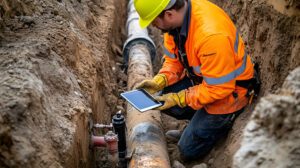I recently spent time with a major utility’s operations manager who walked me through what their field crews face every day – and what I witnessed was eye-opening. Within minutes, we were cycling through eight different applications on a ruggedized laptop: an ERP for parts, dual FSM systems for transmission and distribution work, a CIS for customer data, an OMS for outages, a SCADA for real-time monitoring, a GIS for asset locations, plus HR systems for timekeeping and scheduling.
Then came the reality check. Device boot time: several minutes. Network connectivity: intermittent at best. “Here’s the thing,” he told me as we waited for yet another system to load. “Our crews spend more time wrestling with technology than actually doing their work. And half the time, when they finally access the data they need, it’s already outdated.”
Watching him struggle with that 8-pound laptop, I couldn’t help but think: our field crews shouldn’t need a gym membership – they’re getting their workout just carrying the tools we’ve given them. More importantly, they shouldn’t have to fight their equipment to serve our customers. It’s time we built technology that works with them, not against them..
 This scenario is precisely why KloudGin exists. From day one, we’ve always focused on the people doing the work: from field technicians climbing poles in harsh weather to the back office teams managing planning, scheduling, dispatch, customer service, and compliance. Our technology was born in trucks and in the field, designed by people who understand that technology should improve not only the quality of work but also the work-life balance of every utility professional.
This scenario is precisely why KloudGin exists. From day one, we’ve always focused on the people doing the work: from field technicians climbing poles in harsh weather to the back office teams managing planning, scheduling, dispatch, customer service, and compliance. Our technology was born in trucks and in the field, designed by people who understand that technology should improve not only the quality of work but also the work-life balance of every utility professional.
The Fragmentation Problem
The average utility operates 15-20 different systems, often with multiple versions serving different departments. Field crews juggle FSM systems that don’t communicate with asset management or GIS platforms, while customer service teams work with CIS systems that lack real-time field data. Engineers rely on GIS systems that are disconnected from SCADA and ADMS platforms, as dispatchers struggle with scheduling tools that don’t reflect actual field conditions.
This fragmentation creates cascading issues: Manual data entry introduces errors that spread throughout the organization. Information delays mean decisions rely on outdated data. Most critically, the utility workforce lacks access to the complete operational picture necessary for safe, efficient, and satisfying work.
What’s the impact? Resources are misallocated, response times are delayed, safety risks increase, workers are frustrated, and customer experiences fall short. In an industry where reliability and trust are everything, these gaps create both operational liabilities and competitive disadvantages. More importantly, they represent a failure to support the professionals who work hard to serve their communities.
The Power of Unity: A Single Face of Work®
This industry-wide challenge has led us to a fundamental question: What if technology actually served the people using it? At KloudGin, we built our company around a simple principle: every worker should have exactly what they need, when they need it, where they need it. Not another system to learn, not another login to remember, but a unified platform that functions as the central ecosystem for utility operations.
Our philosophy breaks from the traditional approach. Instead of forcing utilities to rip and replace systems that work, we create intelligent unity. Good technology should disappear into the background, amplifying expertise rather than demanding it. When field crews can focus on serving communities instead of wrestling with software, when dispatchers have complete operational visibility, and when customer service representatives give accurate answers in real-time – that’s when technology is working the way it should.

We refer to this as the “Single Face of Work,” which fundamentally changes how utilities operate. One interface delivers everything: real-time asset intelligence, work coordination, customer context, safety protocols, and location awareness—all synchronized across every role. Dispatchers track crew capabilities and real-time locations. Customer service accesses live field updates for accurate restoration commitments. And compliance teams receive automated reports with embedded audit trails.
Our unified EAM and FSM platform achieves this through pre-built integration with existing organizational infrastructure, including ERPs, CIS, OMS, SCADA, ADMS, IoT, and DERMS systems. We don’t ask you to abandon investments that work; we amplify their value by breaking down data silos and creating organizational coherence. Whether you’re managing transmission assets, distribution networks, emergency response, or customer relationships, every decision is based on the same reliable source.
Built for Utility Operations, Designed for Workers
What sets KloudGin apart isn’t just our technology – it’s our deep industry experience and expertise. KloudGin Core arrives preloaded with industry best practices we’ve refined over years of partnerships with leading utilities. We understand how work actually happens in the field, not just how it looks on organizational charts. Our Business Process Library provides field-proven workflows that adapt to your specific operational needs while preserving the methodologies that already work. These off-the-shelf capabilities dramatically reduce implementation risk and accelerate value realization because we recognize that operational continuity can’t be compromised.
Strategic future-proofing guides every architectural decision we make. Our extensibility hub protects your existing technology investments as the industry landscape evolves. When new capabilities emerge – advanced analytics, expanded IoT ecosystems, and grid modernization initiatives – our pre-built integrations minimize complexity and ensure operational stability. Your unified platform evolves with your strategic vision, not against it.

Our AssetIQ engine provides practical, embedded AI and ML capabilities that amplify expertise, transforming operational data into role-specific insights. Predictive maintenance intelligence reaches the right technicians before problems get worse or equipment fails. Resource optimization improves scheduling decisions. Proactive planning becomes routine across transmission, distribution, and customer operations. This isn’t automation for its own sake – it’s intelligence that helps your people excel at what they do best.
KloudGin’s Utility Solutions Ecosystem: The Esri Advantage
Our Esri Gold partnership demonstrates how strategic alliances can enhance customer value. Rather than developing custom geographic integration capabilities from scratch, we created native integration with the industry’s leading GIS platform. This partnership approach reflects our overall philosophy: to leverage best-in-class solutions while eliminating the complexity typically associated with enterprise software ecosystems.
The results are immediate and measurable. Field crews get detailed geographic context without needing to switch between interfaces. Project planners use comprehensive mapping intelligence for design, construction, and maintenance decisions. Customer service representatives pinpoint outage locations instantly and provide customers with accurate information when they need it most. Emergency coordinators use the same geographic data for storm response, ensuring coordinated decision-making across all levels.

Our out-of-the-box integration with both Esri Utility Network and Esri Geometric Network demonstrates this philosophy in action. Specialized users, including GIS analysts, network engineers, and system planners, retain access to the advanced tools their expertise demands. Meanwhile, field crews, dispatchers, and customer service teams get the geographic intelligence they need without unnecessary complexity. Everyone works from the same reliable geographic foundation, but each role accesses precisely the capabilities their responsibilities require.
Operational Excellence occurs when standardized workflows are combined with real-time intelligence. Tasks are completed faster, and first-time fix rates improve significantly. Field crews spend their time solving problems rather than fighting systems. Dispatchers make smart decisions with complete operational visibility. Planners optimize schedules using live asset intelligence instead of historical assumptions.
Workforce Engagement increases when technology enhances, rather than hinders, professional capabilities. Removing system complexity and redundant data entry lets skilled professionals focus on the meaningful work they’re trained to do. When technology supports productivity instead of blocking it, work-life balance improves organically.
Customer Value grows through unified operational intelligence. Faster response times, accurate restoration estimates, and proactive outage communication become standard service. Customer satisfaction rises as service reliability improves across every touchpoint.
Financial Performance improves through operational efficiency gains that directly impact the bottom line. Lower integration costs, eliminated data redundancy, and optimized resource deployment create measurable savings. Many utilities achieve first-year ROI through efficiency improvements alone.
Enterprise Risk Management strengthens when complete, real-time information supports safety protocols and regulatory compliance. Standardized processes ensure consistent execution across all work types and asset categories, reducing operational and compliance risks.
Strategic Flexibility increases through future-ready architecture that enables rapid technology adoption without operational disruption. When new business models or technologies emerge, your platform supports strategic initiatives instead of limiting them.
Looking Forward
The energy and public sectors face a critical turning point: Aging infrastructure requires massive investment in maintenance. Renewable energy integration requires new operational approaches. Customers expect real-time transparency and proactive service. Regulatory frameworks grow increasingly complex and demanding. Succeeding in this environment requires more than incremental improvements – it necessitates operational transformation built on unified intelligence and empowered workforces.
Our embedded applications approach addresses this transformation challenge by following the principle that has driven us from the beginning: putting workers first. When every professional has precisely what they need, when they need it, where they need it, utilities can focus on their core mission – delivering safe, reliable, and sustainable services while supporting the skilled professionals who make it possible.
Utilities that eliminate internal friction while maintaining operational excellence across all functions, work types, and asset classes will have the competitive advantage. A unified platform serving your entire workforce isn’t just a technology decision – it’s the strategic foundation for thriving in an increasingly complex industry. The capability is here today. The question is whether you’ll lead this transformation or follow it.
Join us at the Esri User Conference in San Diego, California, from July 14 to 18, 2025. Visit our team at Booth 014 to see firsthand how the KloudGin Field and Asset Operating System, with embedded Esri GIS, delivers a Single Face of Work for utility operations. Schedule your meeting today to explore how unified platforms can enhance your operational capabilities and support your most valuable asset: your people.

About the Author
Vikram Takru serves as Chief Executive Officer of KloudGin, where he leads the company’s strategic direction and growth initiatives. A seasoned technology executive with over two decades of industry experience, Vikram has established himself as a visionary in field service and asset management solutions.
Under his leadership, KloudGin has developed the utility industry’s only cloud-native, mobile-first combined field service and asset management platform. This innovative solution eliminates operational silos and delivers critical information to field crews when and where they need it most.
Before founding KloudGin, Vikram successfully built and led Frontline Consulting Services (FCS), scaling the company to 500+ employees and more than $40 million in revenue in under four years, culminating in a successful acquisition by TEKSystems. Earlier in his career, he held the position of Senior Director of R&D at Oracle.
Vikram’s deep industry knowledge and commitment to technological innovation continue to drive KloudGin’s mission to transform field operations and asset management for utilities through connected, cloud-based solutions.

